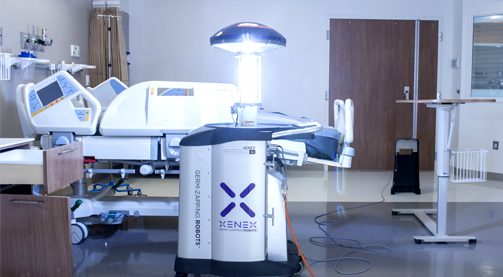
Hospital Hygiene White Book highlights importance of technological innovation
- Studies put the number of avoidable HAIs at 56.6 per cent of total, with an estimated cost of €800 million to the National Health System
- Up to 40 per cent room for improvement in environmental hygiene in healthcare centres
- New automated disinfection methods can eliminate 99.9% of microorganisms, minimising the probability of contracting HAIs.
Madrid, 5 January 2015. Healthcare-associated infections, known as HAIs, are currently one of the main challenges faced by healthcare centres due to their huge impact both on patients’ health and on the use of resources in healthcare centres. Some studies put the number of avoidable HAIs at 56.6 per cent of the total, and estimate that they cost the National Health System around €800 million.
Faced with this scenario, experts stress the importance of technological innovation to act as a complement to traditional and manual methods of cleaning in the healthcare sector. This is one of the main conclusions drawn from the Hospital Hygiene White Book. Presented last month in Barcelona and Madrid, this study was conducted by the Antares Consulting company with the collaboration of more than 30 national and international experts. It was sponsored by the multiservices company Clece.
In Spain, according to the latest available EPINE report (Study of Prevalence of Nosocomial Infections in Spain), the prevalence of HAIs at admission is as high as 5.6 per cent. Faced with this problem, “hospital hygiene is a crucial and indispensable element,” states Bernardo Ubago, the Director of Antares Consulting.
Dealing with HAIs involves two complementary and synergic elements, namely the personal hygiene of professionals and environmental hygiene. “In regard to the cleaning and disinfection of hospital surfaces and patient stays, there is a 40 per cent room for improvement,” adds Bernardo Ubago. “This is due to the fact that traditional hospital cleaning and hygiene has been typified by its manual aspect, technological stagnation and very little innovation, which means that technological innovation is going to become a driving force in this area.
Synergy of new technologies and traditional methods
The combination of automated disinfection methods combined with more traditional manual cleaning produces notably improved disinfection results, reducing the number of microorganisms present on surfaces by up to 99.9 per cent, thereby minimising the probability of contracting HAIs.
Latest advances in hospital disinfection: Xenex robot
One of the chief methods of automated disinfection is the use of mercury and xenon UV lamps, vaporised hydrogen peroxide and ozone systems, which are being progressively introduced into the healthcare environment to complement and optimise the traditional methods used.
One of the latest technological landmarks is the Xenex robot, which is currently operating in two Spanish hospitals: the Hospital General in the Valle Hebrón Healthcare Complex in Barcelona, in the Intensive Care Unit, and the Hospital de La Fe in Valencia, in the Inpatient Oncology Unit. Using UV light generated by Xenon gas lamps, the robot destroys pathogenic micro-organisms such as bacteria, fungi and viruses, in just a few minutes. The technology has been used to disinfect patients with the Ebola virus in US hospitals.
“After five months of work, scientific data produced by the National Biotechnology Centre (CNB), part of Spain’s Scientific Research Council (CSIC), have shown this system’s high capacity for disinfection, with an effectiveness of more than 99.9999 per cent of viruses and spores,” explains Clece, the only company in Spain providing this service.
